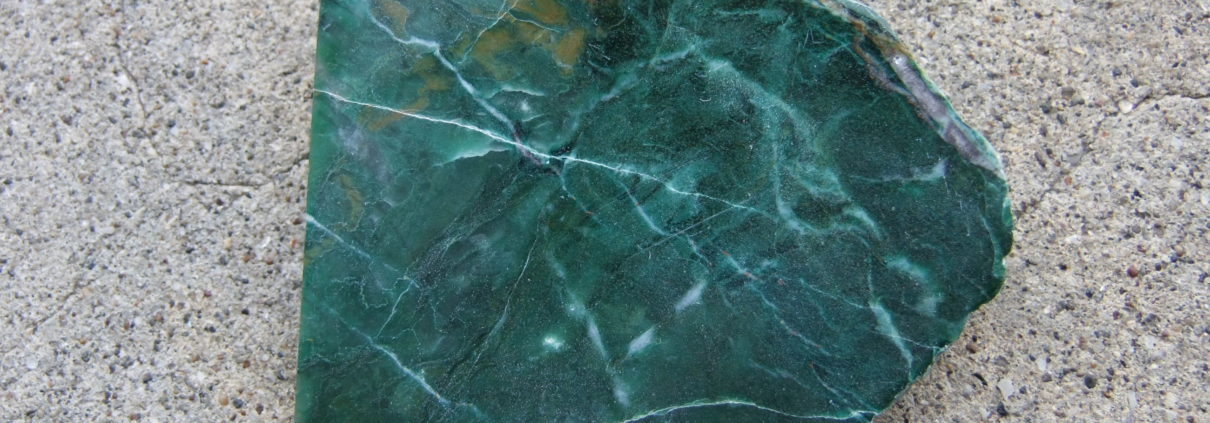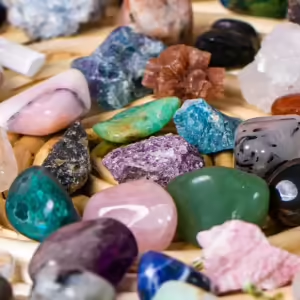Verdite
Verdite is a striking green rock that has captured the attention of geologists, mineral collectors, and jewelers alike. Known for its vibrant hues that range from deep forest green to lighter, jade-like shades, verdite is primarily composed of a mineral called fuchsite, a chromium-rich variety of muscovite mica. This stone’s unique coloration and mineralogy set it apart from other green stones, making it a significant and intriguing mineral within geology, mineralogy, and the jewelry industry.

Verdite is often referred to as “African Jade” because of its similarity in appearance to jadeite and nephrite; however, it is distinct in both composition and geological origin. Predominantly found in South Africa and Zimbabwe, verdite is formed within ancient, metamorphic rocks that date back billions of years, adding to its allure and historical significance.
Contents
- 2. Geological Formation of Verdite
- 3. Physical and Chemical Properties
- 4. Verdite’s Distribution and Mining Locations
- 5. Historical and Cultural Significance
- 6. Uses in Jewelry and Sculpture
- 7. Scientific Studies and Research
- 8. Economic Impact and Trade
- 9. Conclusion
2. Geological Formation of Verdite
Verdite’s genesis is deeply rooted in the geology of the earth’s ancient crust. Most verdite deposits are found within the Precambrian metamorphic belts of Southern Africa, specifically in Zimbabwe and South Africa, where they formed around 2.5 to 3.5 billion years ago. These regions are part of cratons—old and stable parts of the Earth’s lithosphere—that were subjected to extensive tectonic pressures and temperatures, leading to metamorphism.

2.1 The Role of Chromium
The intense green coloration of verdite is due to the presence of chromium within the fuchsite mica. Chromium is a trace element that imparts green hues to several minerals, including emerald (beryl) and jade. In verdite, chromium substitutes aluminum in the fuchsite structure, altering its color spectrum. This inclusion of chromium also makes verdite an ideal study subject for mineralogists interested in chromium-bearing minerals.
2.2 Metamorphic Conditions
Verdite’s formation involves complex metamorphic processes, specifically regional metamorphism, which subjects rock to elevated pressures and temperatures over vast areas. Over time, sediments and igneous rocks buried deep within the Earth’s crust underwent recrystallization. This process transformed existing minerals into the chromium-rich fuchsite, alongside other associated minerals like talc, chlorite, and quartz. These minerals crystallized together, giving verdite its characteristic green color and smooth, almost soapy texture.
3. Physical and Chemical Properties

Verdite’s primary mineral composition is fuchsite, which has a layered structure typical of micas. This gives the stone its characteristic sheen and slight transparency. It has a Mohs hardness of approximately 3-4, making it relatively soft compared to other gemstones like quartz or corundum. This softness has implications for its use in jewelry, as it is prone to scratching and abrasion.
The composition of verdite is variable and can include a mix of other minerals:
- Fuchsite: The primary component, giving verdite its green color.
- Quartz: Often found as inclusions, adding rigidity and sometimes translucency.
- Talc and Chlorite: Contribute to the stone’s softness and soapstone-like feel.
3.1 Structural Characteristics
As a form of mica, verdite has a distinct cleavage, allowing it to split easily along parallel planes. This cleavage pattern is caused by the weak bonds between layers of mica, making the stone easy to carve but susceptible to flaking. This property has made verdite a popular material for carvings, statues, and intricate sculptures, especially in Zimbabwe, where verdite carvings are a cultural art form.
4. Verdite’s Distribution and Mining Locations

4.1 Major Deposits
Verdite is predominantly found in two countries:
- Zimbabwe: Known for its high-quality verdite with a vivid green hue, often used in traditional Shona carvings.
- South Africa: While verdite from South Africa may exhibit slightly different shades of green, it shares the same geological origins as Zimbabwean verdite.
4.2 Mining Techniques
Mining verdite is challenging due to the depth and ancient nature of the deposits. It is typically extracted through small-scale artisanal mining, although larger mining operations have been known to access verdite deposits in areas where it coexists with other valuable minerals like gold and platinum.
5. Historical and Cultural Significance
In African history, verdite has held both spiritual and cultural value. It was often associated with good fortune, prosperity, and protection. Zimbabwean artisans, especially from the Shona tribe, have long carved verdite into figures, amulets, and decorative pieces. These carvings are traditionally associated with storytelling and are used to depict ancestral spirits, deities, and animals. Today, these works of art are highly regarded in both African and international markets, bridging cultural heritage with artistic expression.
6. Uses in Jewelry and Sculpture

While verdite is too soft to be widely used in high-wear jewelry, it remains popular for inlays, cabochons, and ornamental items. Its unique green color and smooth texture make it an attractive material for jewelry designers who value its natural, earthy aesthetic. Sculptors also favor verdite for its workability, crafting detailed statues and intricate figurines that showcase the stone’s natural beauty.
7. Scientific Studies and Research

Because verdite is primarily composed of chromium-rich fuchsite, it is often studied alongside other chromium-bearing minerals to understand the processes that lead to chromium incorporation in minerals. Geologists are particularly interested in verdite’s formation conditions, as they provide insights into ancient tectonic environments and the metamorphic history of Southern Africa.
Verdite has also been the subject of research in terms of its isotopic age, helping scientists to date geological events in Southern Africa. This data has added valuable information to the study of the Earth’s early crust and the processes that led to the formation of the continents.
8. Economic Impact and Trade

Verdite plays a small but notable role in the economy of Southern Africa. The global trade of verdite is relatively limited compared to other gemstones, but its high demand within the art market, especially in the form of Shona carvings, provides income to local communities. These carvings are often sold as part of the cultural tourism industry, which supports many artisans and promotes African art worldwide.
9. Conclusion
Verdite stands as a symbol of geological history and cultural artistry. Formed billions of years ago, verdite is more than a beautiful green stone; it is a window into the ancient processes that shaped the Earth’s crust and a testament to the artistic legacy of the people who have lived alongside it for centuries. Whether studied by scientists, carved by artisans, or admired by collectors, verdite remains a unique and invaluable gem, embodying both the natural and cultural heritage of Southern Africa.


Leave a Reply
Want to join the discussion?Feel free to contribute!